Back at the Falls
Pevans made it to the Gathering of Friends
My report is written as a narrative to be read through and focuses on the new (to me) games I played, as well as the social side of the Gathering. You can use the indexes below to take you to specific sections or games.
It is also available as a PDF document: Gathering of Friends 2016 report (2.7 Mb). (You will need Adobe Reader to view this document – use the link to download it if necessary.)
- List of games
- Day 1: getting there and finding Mega Civilization
- Day 2: brain melting and dodging meteors
- Day 3: Of Xenon and villages
- Day 4: Trivia and five-year missions
- Day 5: From Liars' Dice to prizes
- Wrapping up and heading home
- About the Gathering
List of games mentioned
| Title | Publisher/Distributor | Rating |
|---|---|---|
| Above and Below | Red Raven Games | 7 |
| Agents of SMERSH | 8th Summit | 4* |
| America | Bézier Games | 8 |
| CVlizations | Granna | 8 |
| The Gallerist | Eagle-Gryphon Games, Fire On Board Jogos, Giochix | 9* |
| Imhotep | Kosmos | 8* |
| Karuba | Haba | 6* |
| Kashgar | Kosmos | 8* |
| King Chocolate | Mayfair Games | 5* |
| Magecraft | Crimson Designer | 4* |
| Mega Civilization | 999 Games/Pegasus Spiele | 10** |
| Memoir '44 Overlord game | Days of Wonder | 9 |
| Meteor | Mayday Games | 8* |
| My Village | eggertspiele | 7* |
| Pirates of the 7 Seas | IDW Games | 6* |
| Porta Nigra | eggertspiele | 8* |
| Quadropolis | Days of Wonder | 7* |
| Star Trek Five-Year Mission | Mayfair Games | 6 |
| Die Tore der Welt: das Kartenspiel | Kosmos | 6* |
| Treasure Hunter | Queen Games | 5* |
| West of Africa | Blackfire Entertainment | 6* |
| Xenon Profiteer | Eagle-Gryphon Games | 9* |
| * Provisional rating based on playing just once ** Provisional rating based on whimsy |
||
About the Gathering
This year’s event was the 27th Gathering of Friends, which started out as a weekend get-together by a bunch of gamers, led by Alan Moon (now well known as the designer of Airlines, Elfenland, Ticket to Ride et al). The following year they did it again, bringing some friends with them. This is the abiding principle of the Gathering of Friends: everybody who comes is a friend (and is invited by Alan). This makes for a very convivial, relaxed atmosphere in which anyone can walk up to anyone and ask to join or start a game. Never mind six degrees of separation, at the Gathering it’s hard to find someone more than two away.
Over the years, the Gathering has expanded in time and space – and moved, too, arriving in Niagara Falls in 2011. Games designers bring prototypes to test and games publishers attend. However, the emphasis remains on playing games and having fun. The event would be recognisable to anyone who’s attended a UK convention. It consists of people playing games – most of which they’ve brought with them. I always have a good time and meet up with old friends.
Day 1: getting there and finding Mega Civilization
Having missed last year's Gathering of Friends, it was a great feeling to be en route to Niagara Falls again. My transatlantic flight took me into Charlotte (a change from my usual hub, Chicago) to pick up a connecting flight to Buffalo. Prepared for chilly temperatures in Buffalo, I was over-dressed for the warmth in Charlotte. So was my companion for the rest of the journey, another Gathering regular and all-round good guy, Greg Schloesser (he's also the editor of Counter). Greg happened to be on the same flight to Buffalo, which gave us plenty of time to catch up before we got to the hotel in Niagara.
Once I'd checked in, the first thing to catch my attention was the 18-player game of Mega Civilization that was going on in the Board Room. If you've read my report from last year's Spiel games fair, you'll know that this is a development of the classic original that extends the board from the Atlantic coast to the Indian sub-continent. Eighteen players is the maximum and I anticipate such a large game will only happen at a big convention like the Gathering.
The annoying thing is that it ended up being scheduled before I arrived, so I couldn't take part. Talking to some of the participants, it seems they brought the game to a satisfactory conclusion after some 10 hours play. Apart from the 18 players, two others assisted with running the two trading groups (East and West) to speed things up. The people I talked to were happy to have taken part, but thought they probably wouldn't try it again. My aim is to get a game at a UK event (MidCon anyone?), but I don't expect it will be the full 18.
-GoF16.jpg)
The eastern end of the Mega Civilization board with the game in progress
After a bite to eat, I hunted out my roommate - Pete Card, as usual. He was with one of our Gathering buddies, the ever-enthusiastic Walter Hunt. We decided to try Porta Nigra, the 2015 game from designer duo Michael Kiesling and Wolfgang Kramer, published by eggertspiele (et al). We roped in Rik van Horn as our fourth player - and teacher as Rik had played it before. As you'd expect with a Kiesling and Kramer game, this has lots of ways of scoring points through clever, interlocking mechanisms.
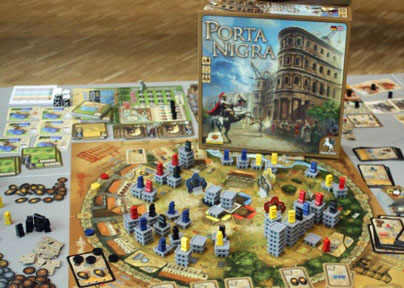
Porta Nigra on display at Spiel ’15 (photo by Mike Dommett)
Although the game's board is square, the playing area is a circle, divided into four quadrants. Depending on which quadrant their 'master builder' piece is in, players will be able to buy a particular colour of 'brick' and build certain buildings - these score points differently in each quadrant. The bricks are actually little plastic building storeys which stack up nicely to make realistic looking buildings which players mark with a pawn in their colour. In between buying 'bricks' and using them, players have to store them in the appropriately coloured bays of their player board. Managing your stock of bricks is clearly a key element of the game.
The actions players can take each turn are also limited by their hand of action cards. A clever touch is that each card gives the player a number of actions as well as the types of action. Having played a card and carried out actions, players draw another card. The round ends when all players have played all their cards. Thus you know what actions you will get during the round, but not the order in which they will be available.
The game lasts a set number of rounds, depending on how many are playing, but may be cut short. The final scoring at the end of the game seems to be where most points come from. Based on this experience, I'd say a lead before the final scoring is useful, but not necessarily decisive. Porta Nigra is a clever game that I thoroughly enjoyed playing and will certainly be playing again. It gets a provisional 8/10 on my highly subjective scale.
Day 2: brain melting and dodging meteors
That was enough for me on my first evening - it was five in the morning on my internal clock, after all. The following morning Pete and I went for breakfast in the hotel. Now, the hotel doesn't actually have a restaurant. It has TGI Fridays and Rainforest Café. Breakfast at Fridays was ... indifferent. We'd definitely be trying somewhere else the next day (following what I think of as the American model of not breakfasting in the hotel you're staying in).
Back to the games: Ken Hill, another Gathering acquaintance of many years, recruited Pete and me for some play-testing. For this we joined our old sparring partner, Leo Tischer, and Scott Tepper. The prototype was a science fiction-themed game from the designers of Fleet. The first rule of testing prototypes is that you don't talk about testing prototypes. So let me just say that the game features a roundel-style mechanism for gathering resources while players' actions are constrained by the dice rolled by the first player each round. We had good fun and it felt like the game was almost finished. We had some discussion afterwards, but I don't think it needs any more than tweaking. I look forward to seeing the finished article.
.jpg)
Just to prove I do get out of the hotel, here’s what’s a few hundred yards away (with Canada in the background)
Pausing for coffee - the hotel doesn't do coffee, it has Starbucks - I finally bumped into my (and Pete's) regular gaming buddies, Ann and Steve Lesnik. Coffee in hand, I followed them back to the games where we decided to give The Gallerist a try. This is the latest game from designer Vital Lacerda and caused a stir at Spiel last year. I missed it there, so was eager for an opportunity to try it. Kris Gould, designer of some fine games himself, spotted us setting up and stopped by to teach us. This was a great help as The Gallerist, like Senhor Lacerda's other games (CO2, Kanban, Vinhos), is very complex.
The idea is that players are sponsoring and promoting artists and making money from selling their works - most money wins the game. The centre of the game's large board shows the players' 'art galleries' around a central plaza. Between the galleries are action spaces. Moving your 'gallerist' pawn to one of these allows you to take one of the two related actions of that space. One interesting mechanism is what happens when a gallerist is moved to an occupied space. It replaces the piece already there, but the 'kicked out' player then gets an extra action - albeit at a cost. This gives players something else to consider when deciding what action to take.
The board also has spaces for: stacks of artists' works in four categories; contract cards for players to sell works of art; media tokens for promoting artists; the international market with immediate and game-end bonuses; stacks of 'tickets', used to move 'visitor' pawns between galleries where they are needed for certain actions. On top of this, each player has their own board with spaces for: the works of art they own; the contracts they've taken on; their 'assistant' pawns, which can be recruited and then deployed for some actions; tickets held; reputation tokens earned. Phew!
-board-GoF16.jpg)
The Gallerist in play – yellow’s been kicked out and about to get an extra action, while red's at home
Despite all this, playing each turn is pretty straightforward. It's deciding what course of action to take that is difficult. There are clearly lots of ways of scoring points through the game. The trick is finding a path that works better than the other players' routes. I survived my introduction to The Gallerist with minimal brain melt and thoroughly enjoyed the game. I am keen to play it again, so it gets a provisional 9/10 on my highly subjective scale.
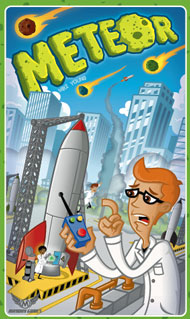 After an early dinner, I and a few others were roped in to play one of Kris Gould's prototypes. This seemed to be at an early stage of development - to me it seemed over complicated, so I'll be interested to see what Kris does to it next. Following this, Mike Young introduced us to his quick-fire game, Meteor (published by Mayday). This is a co-operative card game that plays in five
minutes. It has five
one-minute sand-timers to make sure of this. The idea is that a stream of meteors is heading for Earth: players must destroy them all to win the game.
After an early dinner, I and a few others were roped in to play one of Kris Gould's prototypes. This seemed to be at an early stage of development - to me it seemed over complicated, so I'll be interested to see what Kris does to it next. Following this, Mike Young introduced us to his quick-fire game, Meteor (published by Mayday). This is a co-operative card game that plays in five
minutes. It has five
one-minute sand-timers to make sure of this. The idea is that a stream of meteors is heading for Earth: players must destroy them all to win the game.
It starts with a bunch of meteor cards being dealt out (face down, which gives an idea of their size, but not the exact value). Each player gets a hand of cards showing rockets, fuel and technologies and the first timer starts. Each player can have at most one rocket on the 'launch site' in front of them, but all players can add cards to any launch site. Once a rocket has enough of the right fuel, the player calls "launch" and fires the rocket at a meteor. If the rocket is big enough, the meteor is destroyed (a tactical subtlety is that a weak rocket lets you find out the exact strength of a meteor).
When the first timer runs out (or everybody passes), players get additional cards and the next timer starts. After all five, the players win if they have destroyed all the meteors. Otherwise all life on earth is wiped out. So to speak. A key point is that players cannot talk to each other - until someone plays a 'communications satellite' card. This leads to much frantic scanning of the table to see who's played what and the tricky decision of whether to play cards in front of you or hang on to them to add to someone else's rocket.
Meteor is terrific fun and a great little filler (though it does need a bit of set-up). We enjoyed it so much, despite losing, that we immediately re-set the game and played again. No way were those pesky meteors going to have the last word! It gets a provisional 8/10 on my highly subjective scale.
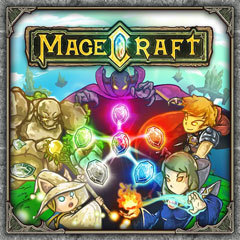 The last game of the day was Magecraft, designed by Percy Chan and published by Crimson Design. We used two copies for a four-player game of duelling wizards, fuelled by lots of plastic 'gemstones' in various colours. These are used to power players' spells and also to show the damage inflicted on each player - last man standing wins (or first to a number of
points in a four-player game).
The last game of the day was Magecraft, designed by Percy Chan and published by Crimson Design. We used two copies for a four-player game of duelling wizards, fuelled by lots of plastic 'gemstones' in various colours. These are used to power players' spells and also to show the damage inflicted on each player - last man standing wins (or first to a number of
points in a four-player game).
Players build up to three 'spell books' of spell cards alongside their character card and can only cast spells from one spell book at a time (and in strict order). They acquire new cards from the selection on the table by spending their gems (rather than using them to cast spells). Each player's stock of gems is held in their drawstring bag. They draw a number of gems from their bag each turn and the gems they have available limit what they can do.
The game is clearly derivative of Dominion, but the designer has given it a clever twist. It's not my cup of tea - particularly with the player elimination aspect - and the duelling wizards theme is hardly new. I give it 4/10 on my highly subjective scale.
Day 3: Of Xenon and villages
For Thursday's breakfast Pete and headed a couple of blocks along the street to a bar Pete had found earlier in the week that offered an all-day breakfast. At 8 am it was pretty empty, but breakfast was definitely on offer (I spotted a selection of craft ales, too, but left them for another occasion) and was much better than we'd had the day before. The bar became our regular breakfast venue for the rest of the week with an increasing number of other Gathering attendees showing up...
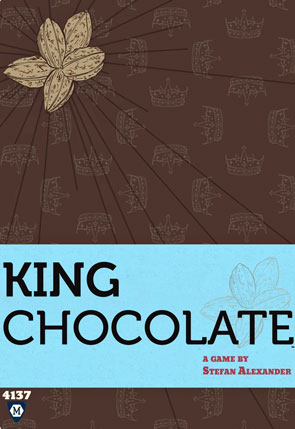 Back at the hotel, Pete and I didn't have to spend long looking for a game, joining newbies Becca and Nathan Morse to try King Chocolate. Designed by Stefan Alexander, this is one of the 2015 crop from Mayfair. Money is the goal in this intriguing game of chocolate production. Cacao beans pass through six stages after harvesting, ending up with chocolate to sell to the
market. This is reflected in the six colours on the tiles players will place each turn. Each tile is two hexagons of different colours with one or two spaces for cacao cubes on each hexagon.
Back at the hotel, Pete and I didn't have to spend long looking for a game, joining newbies Becca and Nathan Morse to try King Chocolate. Designed by Stefan Alexander, this is one of the 2015 crop from Mayfair. Money is the goal in this intriguing game of chocolate production. Cacao beans pass through six stages after harvesting, ending up with chocolate to sell to the
market. This is reflected in the six colours on the tiles players will place each turn. Each tile is two hexagons of different colours with one or two spaces for cacao cubes on each hexagon.
The first thing players do in their turn is lay a tile (they start with three, hidden behind their screen). Then they get three actions to move cubes between production stages (onto '1' tiles, from '1' to '2' and so on until they are removed from '6' tiles), place or move a worker pawn (to take ownership of a group of hexagons in the same colour) or draw a tile. Whenever cacao cubes are moved off a group of tiles, the owning player gets cash from the bank. Hence, owning all the stages of production would be very useful. However, players only have four workers, forcing them to generate money for other players at some stages of production.
It also means that placing your tiles is important: expanding your own groups, while trying to close off other players' areas. Early on a player may have a monopoly of a particular production stage. However, as more and more tiles are laid, there will be competition throughout. My first thought was to grab and expand a stage 6 area, on the grounds that all cubes would end up there eventually. In practice, it seemed that stage 1 was more important as this is where new cubes are brought in.
Regardless, it was a close-fought game with a lot of tough decisions, especially when you had to give money to one of the other players. At the start none of us was particularly bothered about which tiles went where but by the end of the game, each tile placement was being carefully thought about. King Chocolate is a clever game that requires a bit of spatial awareness and plenty of cunning. It was, however, a bit too abstract for me (it's essentially about the placement of the six colours of hexagon), so it gets 5/10 on my highly subjective scale.
The next person I bumped into was Steffan O'Sullivan, an old gaming buddy and always a delight to play games with. He was looking for others to play a game he'd just acquired, so Pete and I were quick to join him. The game in question was Xenon Profiteer (designed by "T. C. Petty III", would you believe, and published by Eagle/Gryphon). The title did not fill me with enthusiasm, but the company did.
Xenon Profiteer is a game of brightly coloured glossy cards. The aim is to 'distil' Xenon from the atmosphere and use it to fulfil contracts that require more or less Xenon. Contracts provide money immediately and points at the end of the game. As you'd expect, contracts with more money have fewer points and vice versa. Each player starts with a standard distillation card, which summarises their options each turn, and a deck of 10 cards comprised of air (Nitrogen, Oxygen, Krypton and Xenon) and a couple of standard 'upgrade' cards. Players shuffle their cards and draw five as their starting hand.
-GoF16.jpg)
Playing Xenon Profiteer – available cards in the middle with lots of air to the left
Anyone who's played Dominion will anticipate what's coming next. And they'll be wrong. Well, mostly wrong. Players' immediate aim is to get rid of the other air cards from their hand, leaving them with Xenon cards they can store and use to complete contracts. However, their one 'distil' action each turn only removes one element from their hand (unless they put their plant on 'overtime' and distil twice). Distilled cards are removed from the player's deck.
It can take several turns to get any Xenon, by which time you have very few cards left. You then need more Xenon, but the only way to get it is to add another 'packet' of air: one card of each element. More distilling is required. The result is a constant churn of cards through players' decks, a very different take on the idea of deck management. Upgrade cards can be used to make the process more efficient, but cost money to buy - though this can be reduced with the 'Bid' action. Players can always draft contracts, completing them to provide money and points.
Xenon Profiteer is a cracking little game, despite my initial misgivings. It cleverly stands the deck management idea on its head, providing a game that flows quickly and reaches a speedy conclusion. I give it a provisional 9/10 on my highly subjective scale and will be looking for the opportunity to pick up a copy for myself.
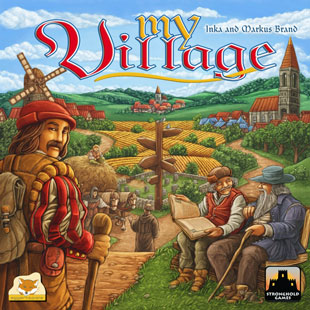 After a break for some warm, brown water from Starbucks (okay, there was probably some caffeine involved too), I joined Herb Levy (the man behind Gamers Alliance) and Gathering stalwarts Ravindra Prasad and June King to try My Village. I passed on My Village at Spiel, on the assumption that it was an expansion for Village. However, it is actually a stand-alone
design from the same designers, Inka and Markus Brand, and publisher, eggertspiele.
After a break for some warm, brown water from Starbucks (okay, there was probably some caffeine involved too), I joined Herb Levy (the man behind Gamers Alliance) and Gathering stalwarts Ravindra Prasad and June King to try My Village. I passed on My Village at Spiel, on the assumption that it was an expansion for Village. However, it is actually a stand-alone
design from the same designers, Inka and Markus Brand, and publisher, eggertspiele.
While the original game had players competing for the actions available in a single village, on the central board, My Village gives each player their own village (board). Actions are powered by the dice which the first player rolls each round. As with the original game, time and death are key elements of the game. Taking certain actions means a player's 'Grim Reaper' pawn moves on. When it completes a circuit, one of the player's worker pawns 'dies' and is placed in the central graveyard, contributing to the 'story' of the village (and thus scoring points).
The actions players can take in their turn are denoted by printed 'banners', either black or white, with numbers. Players choose two dice, add up the pips and can take the action/s with the matching number. Thus players are more likely to be able to take a '7' action than a '12'. Depending on the banner colour, players can take just the one action (black) or all of them (white). White banner actions seem to be less powerful - until you get several of them with the same number.
Actions allow players to: produce goods, money and other resources; attract customers (to buy goods); add buildings (cards) to their village; send out travellers; expand their church; recruit monks; set up a council chamber. There are a lot to choose from and each will provide some benefit in terms of money, resources or the 'story' points needed to win the game. Clearly you can't expect to do all of these. As with Village, players have to work out their own route to success and do so more effectively than their opponents.
I enjoyed My Village rather more than I did Village. I can't put my finger on just why, but I suspect that having my own board, rather than fighting other players for the actions on the central board, has something to do with it. I also like the square cards used. The shape has no effect on game play, I just like it. My Village gets a provisional 7/10 on my highly subjective scale.
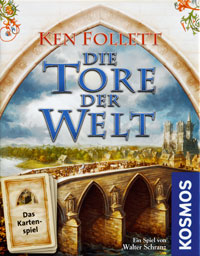 After dinner, I came across Steffan again and found he had another game to try: Die Tore der Welt: Das Kartenspiel. This is the card game based on the board game based on the Ken Follett novel, World Without End (Die Tore der Welt in German), that is the sequel to The Pillars of the Earth, on which a board game was also based.
Confused? Ignore
it all. This is a neat little card game, designed by Walter Schranz and published (in 2012) by Kosmos - one of quite a few Kosmos titles that have not had an English language edition. Marion Adam and Linda Pedlow, two more Gathering regulars, joined us for a four-player game.
After dinner, I came across Steffan again and found he had another game to try: Die Tore der Welt: Das Kartenspiel. This is the card game based on the board game based on the Ken Follett novel, World Without End (Die Tore der Welt in German), that is the sequel to The Pillars of the Earth, on which a board game was also based.
Confused? Ignore
it all. This is a neat little card game, designed by Walter Schranz and published (in 2012) by Kosmos - one of quite a few Kosmos titles that have not had an English language edition. Marion Adam and Linda Pedlow, two more Gathering regulars, joined us for a four-player game.
The game has a neat card mechanism for players to keep track of their resources and victory points. It is played over 24 rounds, divided into two chapters - players must pay taxes at the end of each chapter, but have the preceding rounds to make sure they can (probably) afford to do this. Each round starts with one player drawing an event card. Once this has taken effect, it is positioned with a corner pointing at each player and indicating the bonus for the first player. In turn, players play an action card from their hand, either using it to take resources or points, according to their corner of the event card, or to use the action on the card.
Each action card shows differing numbers of the different resources, so players have to decide how best to use each card. They can only pick up their played action cards by playing the "pick up cards" action or when they have played all their cards. However, the important function of the action cards (and some events) is to allow players to turn resources into points. The player with the most points wins, of course.
Die Tore der Welt: Das Kartenspiel is not a particularly deep game, but it does offer some tricky decision making and is good fun. It is slightly hampered by all the text being in German, but old hands like us take this kind of thing in our stride. I give it 6/10 on my highly subjective scale.
Having enjoyed that, we went on to Karuba, one of the new line of family games from children's game specialist, Haba. Designed by Rüdiger Dorn, it's a fairly light exploration game. Each player has their own board with a grid of squares. To start with, players place 'adventurer' pawns in the same positions on the edges of their board and the matching 'temple' pieces on other edges. The aim of the game is to build a network of pathways - by laying tiles across the grid - to link each adventurer with their temple.

Karuba is almost over: I just have one more explorer to move...
In Take it Easy! style, one player shuffles their tiles and draws one at a time: all players place the same tile from their set. Tiles can't be turned round, but don't have to match any tiles they're next to. Alternatively, a player may discard the nominated tile and move one of their adventurers. In a neat touch, the more useful a tile is for placing on the board, the more useful it is for moving adventurers too. Some tiles show a gem or gold nugget and these are picked up by an adventurer who ends their move on that space.
The game ends if all tiles are out or anybody gets all their adventurers to their goals. Players score points for the gems and gold they've picked up along the way, as well as the points they get for each adventurer that reaches their temple (more points the earlier the player achieves this). Karuba isn't too demanding, but there are some tactical subtleties and it's good fun. It gets a provisional 6/10 on my highly subjective scale.
After this, I introduced the group to Game of Trains, which went down well enough that we played twice (I think they didn't want me to get away with winning the first game!). The group then dispersed, only for Linda and me to both spot Carl Olson teaching Treasure Hunter. We joined Pete, Steve and Greg (who I hadn't seen much of since we arrived) to play this Richard Garfield design from Queen Games.
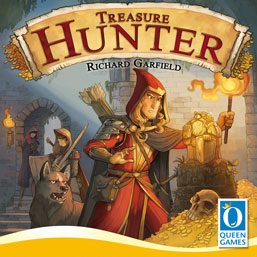 It's essentially a card game. Each round, players compete for treasures and then have to get past a bunch of thieving goblins. There are three pairs of treasures, matching the three suits of 'Adventurer' cards. The player with the highest value set in a suit gets one treasure, the other goes to the player with the lowest value set. Players then have to play 'Watchdog' cards to
keep off the goblins. Anyone without strong enough dogs loses money to them, which is collected by the player with the highest total of watchdogs. On top of this there are action cards and other bonuses that may come into play.
It's essentially a card game. Each round, players compete for treasures and then have to get past a bunch of thieving goblins. There are three pairs of treasures, matching the three suits of 'Adventurer' cards. The player with the highest value set in a suit gets one treasure, the other goes to the player with the lowest value set. Players then have to play 'Watchdog' cards to
keep off the goblins. Anyone without strong enough dogs loses money to them, which is collected by the player with the highest total of watchdogs. On top of this there are action cards and other bonuses that may come into play.
What makes the game is how players assemble their hand of cards before going for the treasure. Initially, everybody's dealt cards at random - even with six players this isn't all the cards, so players can't be sure just which cards are in play. Players chose one of the cards to keep, pass the rest on, choose another from the cards they've been passed and so on. The decision facing each player is what to go for and the bad news is when someone else starts collecting the same thing.
For me, the most interesting thing is how the game develops each round. Players extrapolate from what others did the previous round and try to work out what they're going to do this time. Though, of course, the treasures and goblins in play will influence players' choices. Treasure Hunter is a neat game that plays smoothly and entertainingly (especially with the company I was in), but I'm not sure I need to play it again. I give it 5/10 on my highly subjective scale.
Day 4: Trivia and five-year missions
Returning from breakfast on the Friday morning, I was intercepted by the irrepressible Mary Prasad. She and a couple of others were about to play the pre-production sample of Ted Alspach's latest game, America, and wanted a fourth player. This is a trivia game, except it's a trivia game that Ted has developed from a Friedemann Friese design (specifically, the game published by Ted's company, Bézier Games, last year as Terra). So, each card has three questions on the same topic. One has a date as an answer, one has a (US) state and one is a number. Players have a number of cubes to place on the tracks and map that show the possible answers.
Once the questions have been read out, players take it in turns to place one cube as an answer to one of the questions (or pass). Players get 7 points for the right answer and 3 points for a cube adjacent to the right answer (which could be quite a few if the answer is a state). Thus, you don't necessarily need to know the right answer, just spot who does.
As the questions are all about the US of A, Mary reckoned I was an easy mark. Mistake; big mistake! A lot of the questions were general enough (e.g. on the Invasion of the Bodysnatchers movies) that anybody might know them. On other questions, the other players were often as much at sea as me (such as "Which date does not appear in any other question?"). For some other questions, it was obvious who knew the answer and I could ride on their coat-tails for a few three-point scores.
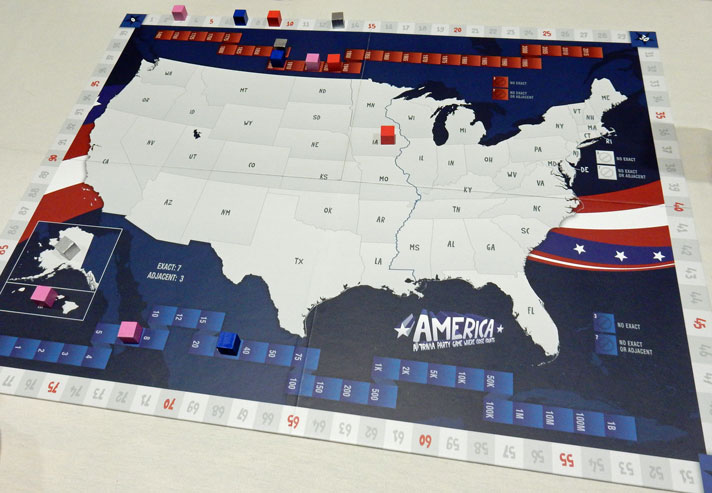
Playing America in America, with Americans...
Winning the game probably helps my attitude towards it, but I think it's a clever take on trivia games. Players don't necessarily need to know the answers, just be able to work out who does. Which means there's the possibility of making tactical moves to try to mis-direct your opponents. Clever stuff, but the title may make it less appealing to non-Americans. I give it 8/10 on my highly subjective scale.
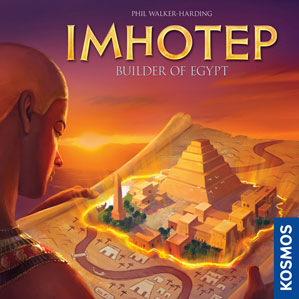 With one change in personnel, we moved on to try one of the latest from Kosmos: Imhotep, designed by Phil Walker-Harding. I particularly liked this for the chunky wooden cubes, in players' colours, that are a main component of the game. They provide a nice, tactile element to the game. There are various sites (boards) to which players can add their cubes. Each of these scores in
different ways: number
of cubes, number visible from the top, tallest stack and so on.
With one change in personnel, we moved on to try one of the latest from Kosmos: Imhotep, designed by Phil Walker-Harding. I particularly liked this for the chunky wooden cubes, in players' colours, that are a main component of the game. They provide a nice, tactile element to the game. There are various sites (boards) to which players can add their cubes. Each of these scores in
different ways: number
of cubes, number visible from the top, tallest stack and so on.
However, getting your cubes there isn't simple. They arrive at one of the sites when a player decides to dock a boat at that site. They can only do this if the boat has a minimum number of cubes and at least one of them belongs to the player. Cubes get onto the boats by players choosing to put one of their cubes onto an available space. In turn, players accumulate cubes by 'quarrying' them.
The sequence is pretty straightforward, but needs some planning. Which can all be ruined by another player choosing to dock a boat. Or dock it in a different place from where you wanted it to go. This is what makes the game so neat. Add in 'market' cards that give bonuses or advantages to players and you've got a really clever game. Imhotep gets a provisional 8/10 on my highly subjective scale.
My next game was another prototype, this time based on an Edgar Allan Poe short story. The best bit was the race against time at the end, but I felt the preparation for this was too long-winded. It'll be interesting to see if this game finds a publisher - and what the finished article looks like.
After picking up some coffee (or a close facsimile), I hooked up with Steve again to try Quadropolis, the new game from Days of Wonder. The brightly-coloured, cartoon-style artwork suggests this is more of a children's game. It is certainly aimed at family play, but there's more than enough to interest gamers in its clever tactical options. We played the "Classic" mode, recommended for first-time players - "Expert" mode adds further complications to the game.
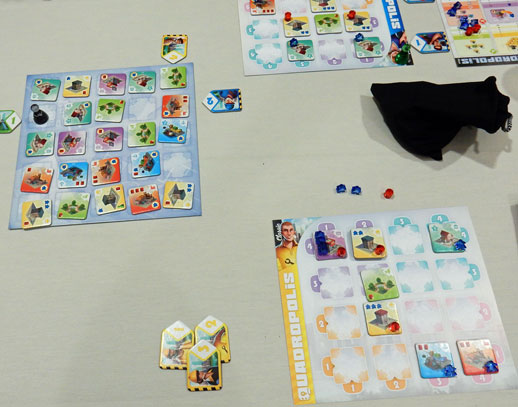
Starting the second round of Quadropolis with a few buildings on my board
The game is played over four rounds, with players selecting and placing four buildings in each round (if all goes well). You take a square building tile from the grid on the central board, according to the value of the 'Architect' you play, and place it on your own board, according to the same value. This sounds simple, but as rows and columns become blocked by players' Architects and the tiles run out, you can find there's nothing you can pick up.
Each tile also brings with it some fuel blocks and/or inhabitant meeples. These are needed at the end of the game to 'activate' buildings so that they score points. However, unused fuel and inhabitants give you penalty points, so you need to plan these carefully. Each type of building scores in a different way: tower blocks for each floor, shops for each customer, harbours for the longest row of these.
Despite the apparent simplicity of the game, there are an awful lot of things to think about: which buildings you can get, how they'll score, what fuel and inhabitants they bring and how you're going to use them. Designer François Gandon has done a good job with his first game, complemented by Days of Wonder's high standard of production. Quadropolis gets 7/10 on my highly subjective scale.
Next, Steve and I thought we'd try West of Africa and recruited Maryl Fischer and Nick Ramsey (more Gathering regulars and gaming buddies) to join us. This is a Martin Schlegel-designed game, published by Blackfire Entertainment, and set around the seven Canary Islands. (These are, of course, to the west of Africa.) Apart from the islands, the board has tracks for players' gold and points - the game end is triggered when anybody reaches 25 points or all the islands' settlements have been taken.
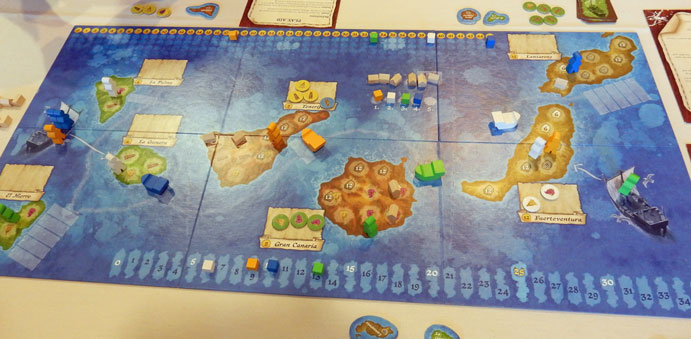
Playing West of Africa: blue’s maxed out on money, but green is in the lead
Players each have a set of action cards, from which they choose the actions they want to carry out each turn. The cards chosen also determine player order for the round, giving players more to think about when choosing their cards. Actions allow players to move their workers (meeples) or ship (carrying goods, usually), plant goods (on matching fields), and sell goods. Particular actions may require players to play their card for the appropriate island, pay gold or use workers.
At the end of each round, the players determine who is Mayor (Alcalde) of each island. Essentially, this is the player with the most bits on the island. The Alcalde may establish settlements - at a cost - on their island and score points for these. As this is the main way of scoring points, competition for the Alcalde positions can be fierce. I found the game a bit fiddly to play, but it's certainly an intriguing game and one I'll be happy to play again. It gets a provisional 6/10 on my highly subjective scale.
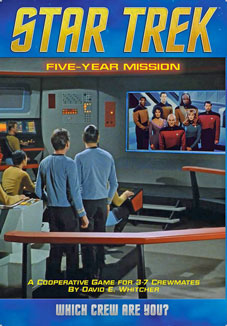 After dinner Kris Gould collected a group to play Star Trek Five-Year Mission - Steve and I were joined by two of our dinner companions, Stance and Cheryl Nixon (more old Gathering friends). Designed by David Whitcher, this is another of the 2015 games from Mayfair. It's a co-operative dice game with the players as the senior crew of the Starship
Enterprise. As you'd expect, each character provides a special ability in keeping with their role in the crew, as shown on the character mats.
One side of these shows the original crew (Kirk, Spock, McCoy et al), the other has the "Next Generation" team (Picard, Ryker, Data etc).
After dinner Kris Gould collected a group to play Star Trek Five-Year Mission - Steve and I were joined by two of our dinner companions, Stance and Cheryl Nixon (more old Gathering friends). Designed by David Whitcher, this is another of the 2015 games from Mayfair. It's a co-operative dice game with the players as the senior crew of the Starship
Enterprise. As you'd expect, each character provides a special ability in keeping with their role in the crew, as shown on the character mats.
One side of these shows the original crew (Kirk, Spock, McCoy et al), the other has the "Next Generation" team (Picard, Ryker, Data etc).
The game is run on dice, but there are also cards. These are the crises and missions affecting the Enterprise and thus the challenges facing the players. They come in three levels (alerts): blue, yellow and red. These are, of course, levels of increasing difficulty - and reward. Players draw a card as the first thing in their turn. Then they roll some dice and try to resolve one or more of the alerts. Fail too many alerts and the team loses. To win, they have to resolve a minimum points value and colours of alerts.
Depending on the alert, resolving it will need specific values of dice of certain colours. Players start with a standard set of dice, but this will change as they use and replace them. Injuries to a crewmember stop them rolling as many dice, making it harder to succeed. It's all too easy to fall into a descending spiral as injuries make it harder to deal with alerts that accumulate and then the game is lost. This puts the players under real pressure.
We had great fun playing the game - hamming up our particular role (well, I was, anyway) - but lost as we floundered under increasingly nasty alerts. We weren't prepared to take that lying down, so we played again (taking different characters) and were successful this time. So the game clearly has appeal, but I feel the luck of the dice is such an overwhelming factor that it's not one I can take too seriously. It gets 6/10 on my highly subjective scale.
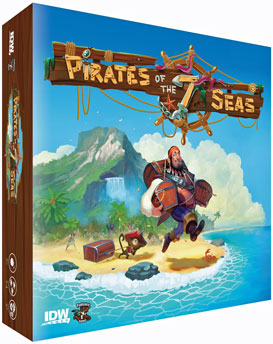 After Kris retired, the remaining four of us played Pirates of the 7 Seas, a game that comes in a chunky square tin. I assume this originates with Ukrainian publisher IGames, since the designers are Oleksandr Nevskiy and Oleg Sidorenko - the English language version is from IDW/Pandasaurus. There are lots of cards in the game, plus a whole heap of
dice! The dice are the ships in players' pirate fleets and rolling them is how battles are resolved. Each player chooses a colour and takes their first ships. They also take a set of 'character' cards, which are the actions available.
After Kris retired, the remaining four of us played Pirates of the 7 Seas, a game that comes in a chunky square tin. I assume this originates with Ukrainian publisher IGames, since the designers are Oleksandr Nevskiy and Oleg Sidorenko - the English language version is from IDW/Pandasaurus. There are lots of cards in the game, plus a whole heap of
dice! The dice are the ships in players' pirate fleets and rolling them is how battles are resolved. Each player chooses a colour and takes their first ships. They also take a set of 'character' cards, which are the actions available.
Each round, players choose a character/action card secretly, then all are revealed. Actions are resolved in a specific order, with a bonus for any player who's the only one to have chosen that action. Actions let players buy more ships, sell goods, draw cards and, of course, plunder merchant ships (playing a card showing the merchant ships). However, in this case everybody gets in on the action, deciding how many ships/dice to send. These are added to the dice for the merchants and then all rolled. Ships sink if the closest die of the opposing side (pirates or merchants) is a higher value. This is great fun - except when your ships sink!
Surviving pirate ships gain booty tiles, placing dice on them to show loaded ships. Goods taken as booty can then be sold to earn 'treasure' tokens, which are players' scores at the end of the game (assuming they haven't spent them on new ships), along with a few other things. In particular, players may earn 'black spot' tiles during the game and these are negative points at the end. One neat touch is that playing a card and then being unable to take the action earns you a black spot. There are also yin-yang tokens that players can earn and then spend to upgrade their fleet.
There are lots of clever details in the game, but it feels more of a family game than a gamers' game. Nevertheless, we had good fun playing, with much anguish over bad dice rolls and crowing over successes. I thought it took a bit long to finish and give it 6/10 on my highly subjective scale.
Day 5: From Liars' Dice to prizes
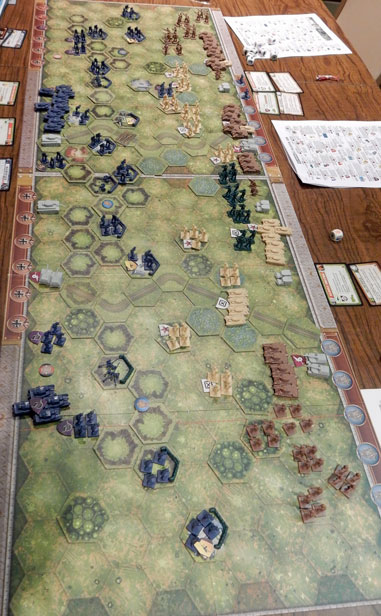
Start of the Overlord game from my end.
My mobile artillery seems to be targeting
Leo’s Tiger (mid left edge of the photo)...
While the Gathering is mostly open gaming, there are some tournaments throughout the week. Saturday morning was Liar's Dice, which Pete and I had both signed up for - it's a cracking game and playing in the tournament has become something of a tradition. I surprised myself by winning through my first round game only to go down in flames in the second.
On leaving the tournament, I was pounced on by Sheila Davis (she and hubby James are old Gathering buddies and serious games collectors), who had organised another Gathering tradition: an Overlord game of Memoir '44. This is a team game with three battlefield generals and a Field Marshall on each side, using two sets of the game to provide a big battlefield. I drew Axis and was the right flank, alongside Leo Tischer and Sheila, with Scott Simon as our boss. Directly opposite me, Stefan Büchtmann was in charge of the Russian left flank with Mario Pawlowski and Terry Egan the other two generals under Field Marshall James.
The scenario we played was Seelow Heights, part of the final defence of Berlin in 1945. The German forces have some serious defences against the superior numbers of Russians, but the Allied team can score 'medals' by breaking through and moving units off the board. There are also medals for the Allies if they take the ridge from which the German are defending and the Axis have a two-medal head start for controlling the towns. I did not like the look of my flank: a few scattered infantry units against a solid line of Russian troops. I had just one armour unit, in reserve, but a couple of artillery units.
As the Russians advanced, I was able to use my artillery to weaken them. This was particularly useful when Stefan got some of his tanks into an attacking position. I countered with my armour and the result was no tanks left. The determined defence paid off in the end, as the Axis team achieved the number of medals needed to win - helped by the bonus for holding the towns, it has to be said. There was not much left of my flank by the end, which I suspect is historically accurate. As always, playing Overlord was a blast with the added entertainment of Leo and I needling each other (think Asterix and Obelix competing over Roman helmets...).
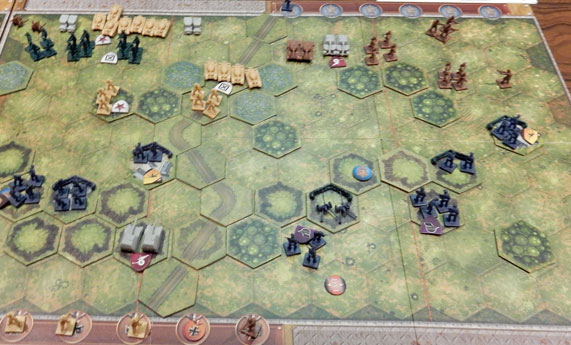
My flank as the game proceeds. I’m sure I started with some tanks...
Wargame over, I linked up with Pete and Steve again to give Above and Below a go. As far as I'm concerned, any game with a paragraph book of adventures has to be tried. Above and Below is published by Red Raven Games and was designed by main man Ryan Laukat. Players have their own village (set of cards), which they develop as they explore their habitat. "Above" is the surface of the land, where players build houses (cards) for their villagers. "Below" refers to the underground caves where players establish outposts that produce goods.
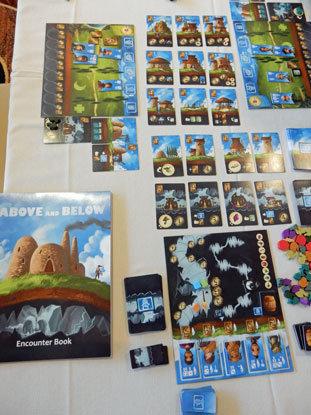
Turn 3 of Above and Below: that’s my board in the
top left with one villager exhausted so far
The paragraph book is used for players' adventures as they explore "Below". I love this feature, but we didn't use it much. I suspect we were missing something, as we also didn't seem to be getting anywhere near the sort of income/production that the game allows for. Players' actions are powered by worker ("villager") placement, but villagers then need to rest - unless they are refreshed by a barrel of cider (no, really!).
The key action is, of course, to explore: choosing a team of villagers to send into the caves and encountering... well, who knows what. This usually produces a challenge, which is when you hope you've sent the right team. You choose a response (run away, fight, negotiate...), roll some dice and see what you get. There are mechanisms for improving on the dice, but you will end up with something.
Above and Below is an ingenious and well-produced game that I found entertaining, ,though I expected more of the paragraph-driven adventures. Definitely one I want to play again, I give it a provisional 7/10 on my highly subjective scale.
The three of us went for an early dinner - and some craft beer sampling - before the Saturday evening proceedings. One of the features of the Gathering is the prize table: bring a prize, take one away with you. While most of the prizes are games, there are all sorts of special items as well. It's a great part of the event and brings everybody together. Hence, it's the opportunity to thank everybody, but speeches are thankfully short.
While the room is being set up for this, we had the "Ice Cream Social" - an opportunity for people to chat, particularly to those they haven't had a chance to speak to so far. This takes place over a bowl of ice cream - sponsored by Rio Grande Games (Jay Tummelson, the man behind Rio Grande, is a regular at the Gathering and all-round good guy) - or two, or six (oooh, I feel sick...).
This year we had something different. Alan cut out the speeches almost entirely and we had thirty minutes of entertainment from Michael 'Mirth' - who had been in my Liars' Dice game. I would sum up his act as comedy magic. He started by subverting our expectations: "Dan, think of a number from 1 to 10 million. I will now write down the next word out of Dan's mouth... Dan, do I have any idea what your number is?" And the answer was, of course "No." He went on to do some clever tricks while being very funny.
Having brought a copy of The Great War for the prize table, I came away with two games. Firefly: Fistful of Credits, a co-operative game where players take the roles of the Serenity's crew to complete missions based on some of the TV series' episodes. As one of the last names called, I also got a copy of Repos's Doctor Panic, a real-time game of doctors and nurses dealing with an emergency - it should be bonkers fun.
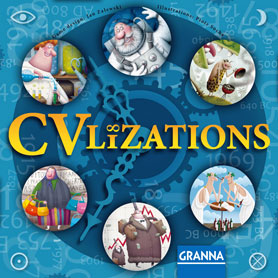 As the games restarted, Pete and I enrolled Steve and another old friend, Dan Luxenburg, in a game of CVlizations. I hadn't played this properly since my demo game at Spiel last October, so it was great to play a full game. It's an entertaining civilisation-development card game where the goal is to have the happiest civilisation (most smiley faces!) after three
eras/nine
rounds.
As the games restarted, Pete and I enrolled Steve and another old friend, Dan Luxenburg, in a game of CVlizations. I hadn't played this properly since my demo game at Spiel last October, so it was great to play a full game. It's an entertaining civilisation-development card game where the goal is to have the happiest civilisation (most smiley faces!) after three
eras/nine
rounds.
Players have a set of action cards and play two each round: one face up, the other face down. Actions are then resolved in numerical order, with the effect depending on the number of players selecting the same action. One player is fine, two is better, but three or more is bad news. I like this clever mechanism, though it does add a memory element to the game: keeping track of who's played what.
Actions allow players to gather resources, which they then use to buy 'idea' cards. These give advantages during the game and smiley faces at the end. The trick is gaining the right resources to put together complementary ideas that provide the most happiness. Designed by Jan Zalewski and published by Granna, CVlizations gets 8/10 on my highly subjective scale. (The game only connects to the publisher's previous game, CV, through the similar artwork.)
Wrapping up and heading home
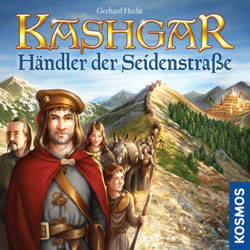 The final Sunday at the Gathering can be a bit of an anti-climax as some people have already left and many more do so through the morning. Having checked out, Pete and I were introduced to Kashgar by Michael Green, with Floyd Sherrold making a fourth. Designed by Gerhard Hecht, it's one of Kosmos's games that has only ever been published in German. Despite this, English translations
of the cards have
been made and we played with one of these.
The final Sunday at the Gathering can be a bit of an anti-climax as some people have already left and many more do so through the morning. Having checked out, Pete and I were introduced to Kashgar by Michael Green, with Floyd Sherrold making a fourth. Designed by Gerhard Hecht, it's one of Kosmos's games that has only ever been published in German. Despite this, English translations
of the cards have
been made and we played with one of these.
Players have three caravans (columns) of cards, starting with Patriarch cards. In their turn, they can play the front card from one of their caravans, moving the card to the rear of the column. The cards do different things: Patriarchs add cards to the caravan - at the back, of course. The aim is to accumulate spices, gold and donkeys, allowing players to complete contracts, thus earning victory points. First to 25 wins.
It is the cards that make the game, of course, and they make a good game. It's clever, entertaining and challenging and I can't understand why there hasn't been an official English language edition. It gets 8/10 on my highly subjective scale and I'm busy playing it some more online at yucata.de (in English).
Traditionally, the last tournament at the Gathering is Can't Stop at lunchtime on Sunday. It's a classic game and I always sign up for the tournament if I don't have to disappear to catch my flight - as Pete had to do this year. I was then drawn against Steve and our German gamer friend, Heli (though I do call her Dr Barthen when I'm being formal). Steve duly thrashed us and went on to win the final, very chuffed at winning his first Gathering tournament.
Meanwhile James and Sheila had accosted Heli and me to join them in trying out Agents of SMERSH. This is a co-operative game that has the players as James Bond-style agents (though Man from UNCLE may be nearer the mark) of the United Nations working to uncover and defeat the plots of SMERSH (in real life a Russian counter-intelligence agency from the 1940s). Designed by Jason Maxwell, this was published by 8th Summit.
This is another game with a story-telling element. However, on top of this is a lot of business with markers and money and dice and positions on the mapboard. Players are, of course, individual characters with their own skills and specific abilities. In Tales of the Arabian Nights style, players move around the board and then resolve an 'encounter' where they stop. This will refer them to a paragraph in the "Book of Encounters" with choices as to how they react and then die rolls to see if they succeed.
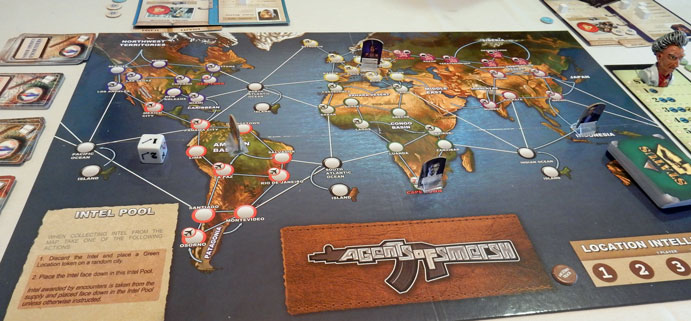
Playing Agents of Smersh
There will be a reward of some sort (intelligence, increased effectiveness with a skill, weaponry etc) for winning the encounter, but losing one will advance the bad guys' cause (represented by a marker on a track). Either way, a character may be injured. Players will eventually have to rest their character to recover, adding to the time pressure.
However, the players' main job is to find the villain's henchmen as they, too, flit about the world. Defeating these guys provides players with information about the villain's lair, enabling them to set up the final confrontation. To win, the players must have a minimum number of intelligence tokens in the right colours (types of intelligence). This is made a bit harder/more random as players don't necessarily know what colours their gathered intelligence tokens are. If the players fail at this, or the villain reaches the end of his track (that is, his dastardly plans come to fruition), the bad guys win.
I did enjoy the story-telling aspect of the game, but the rest was too fiddly and too random. I give Agents of SMERSH 4/10 on my highly subjective scale and it's not likely I'll be playing it again.
We actually drew the game to an early finish as Sheila was taking Mike Fitzgerald (designer of the Mystery Rummy games, amongst others, and another Gathering regular) to the airport. I jumped at the opportunity to cadge a lift as well (though it was slightly early for my flight), so made my goodbyes and headed off. Steve and Ann wished me a "boring flight" on the grounds that this is what you want when it comes to air travel these days! And so it proved to be, with my connection (at Chicago this time) going smoothly and arrival in the UK slightly ahead of schedule.
As always, a huge number of games were played at the Gathering - ranging from prototypes to brand new to very old. The game I noticed most on the tables, though, was Mombasa, which seemed to appeal to a lot of people. Many thanks to Alan Moon and the team who support him for another great convention. I'm already looking forward to seeing everybody again next year!
This report was originally published (in an edited form) in issues 164 and 165 of To Win Just Once (May and June 2016).
